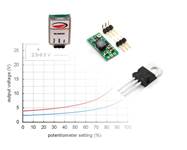
A voltage regulator takes an unregulated voltage where the voltage varies over time and outputs another voltage which is stable over time. This ensures a stable supply voltage to sensitive electronics like 5V, 3.3V microcontrollers or a consistent voltage to motors and lights when the power supply varies over time like a discharging battery.
Most of our regulators are high efficiency switchmode/switching regulators that use a bunch of electronics to convert and stabilize the voltage. Simpler linear regulators use less complex circuits to regulate a voltage but dissipate a lot of energy as heat to keep the voltage stable so they are less efficient.
Step up (Boost) regulators take a variable low voltage and convert it to a higher stable voltage. Step Down (Buck) regulators take a variable high voltage and convert to a lower stable voltage. Combination Up/Down regulators are even more fancy and can convert an unstable voltage up or down.
Regulators are specified as the maximum nominal current they can supply at the regulated voltage. Check the input voltage specs to ensure the regulator will not be damaged by excessive voltages and voltage spikes.